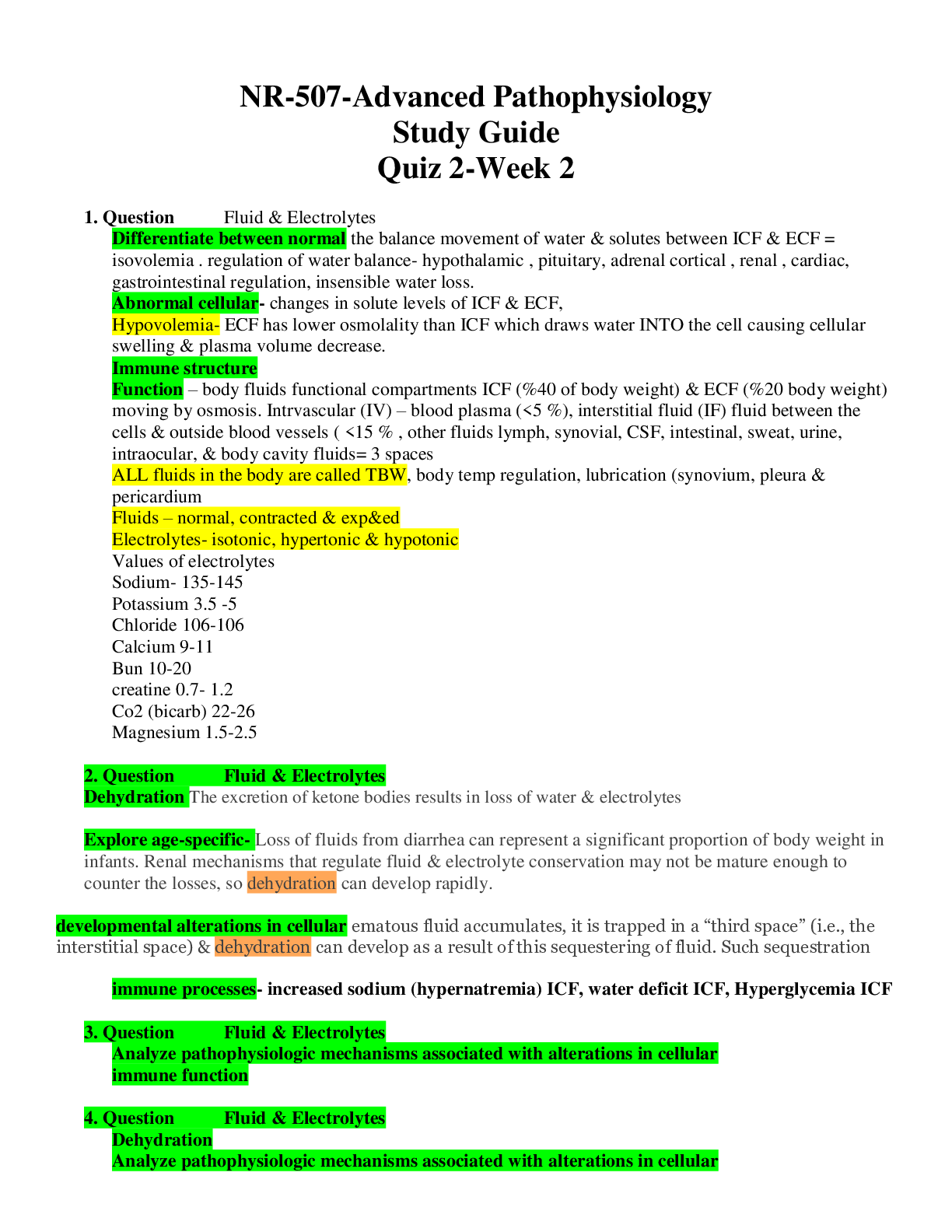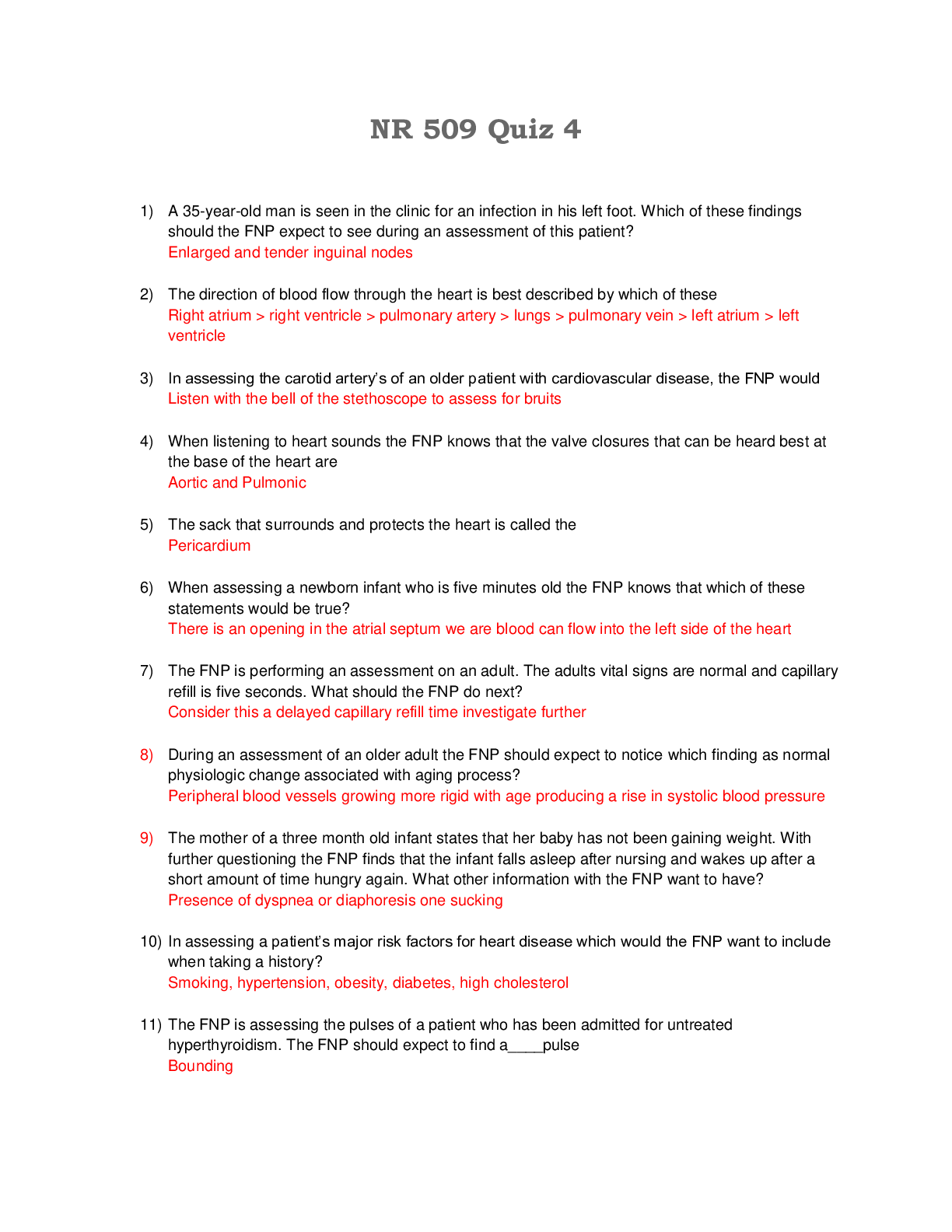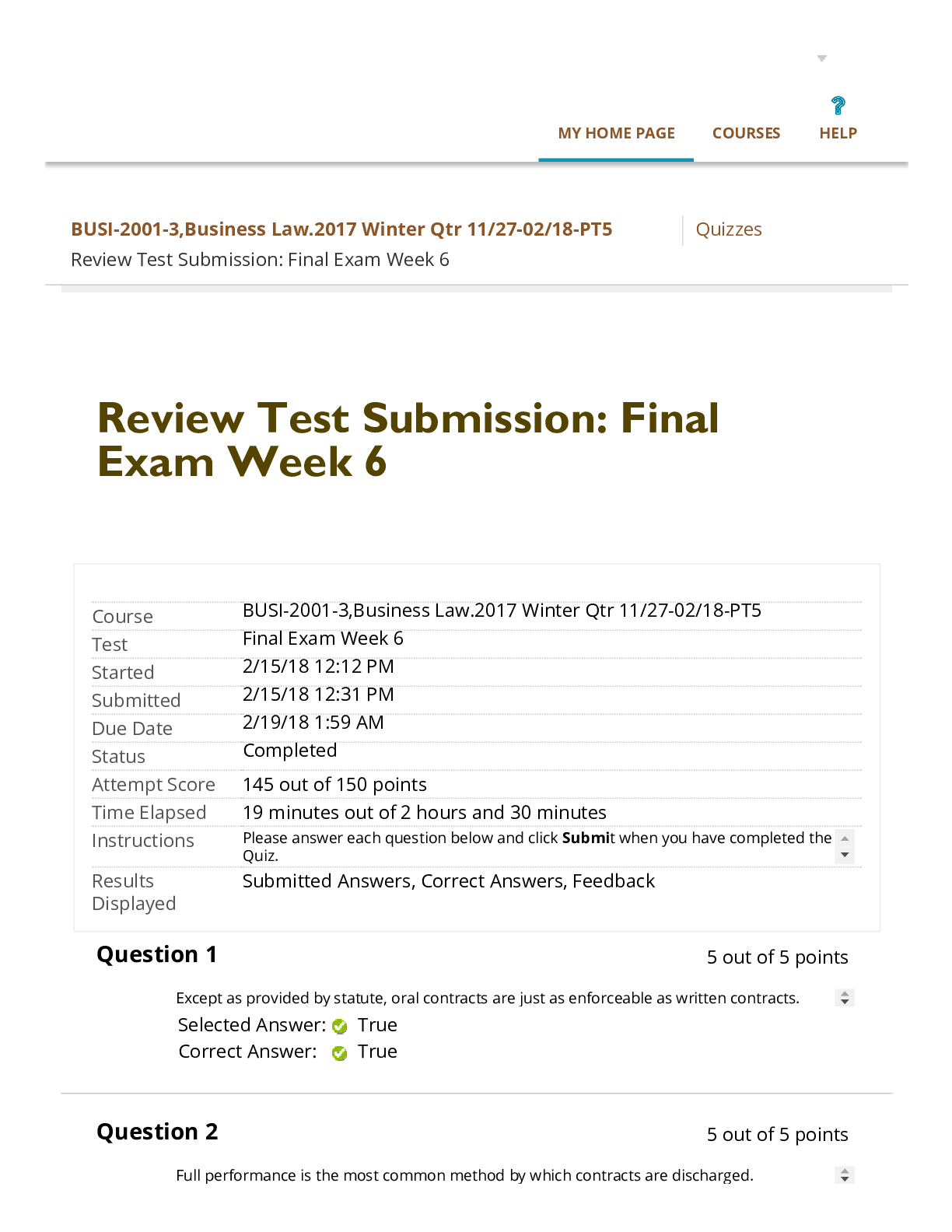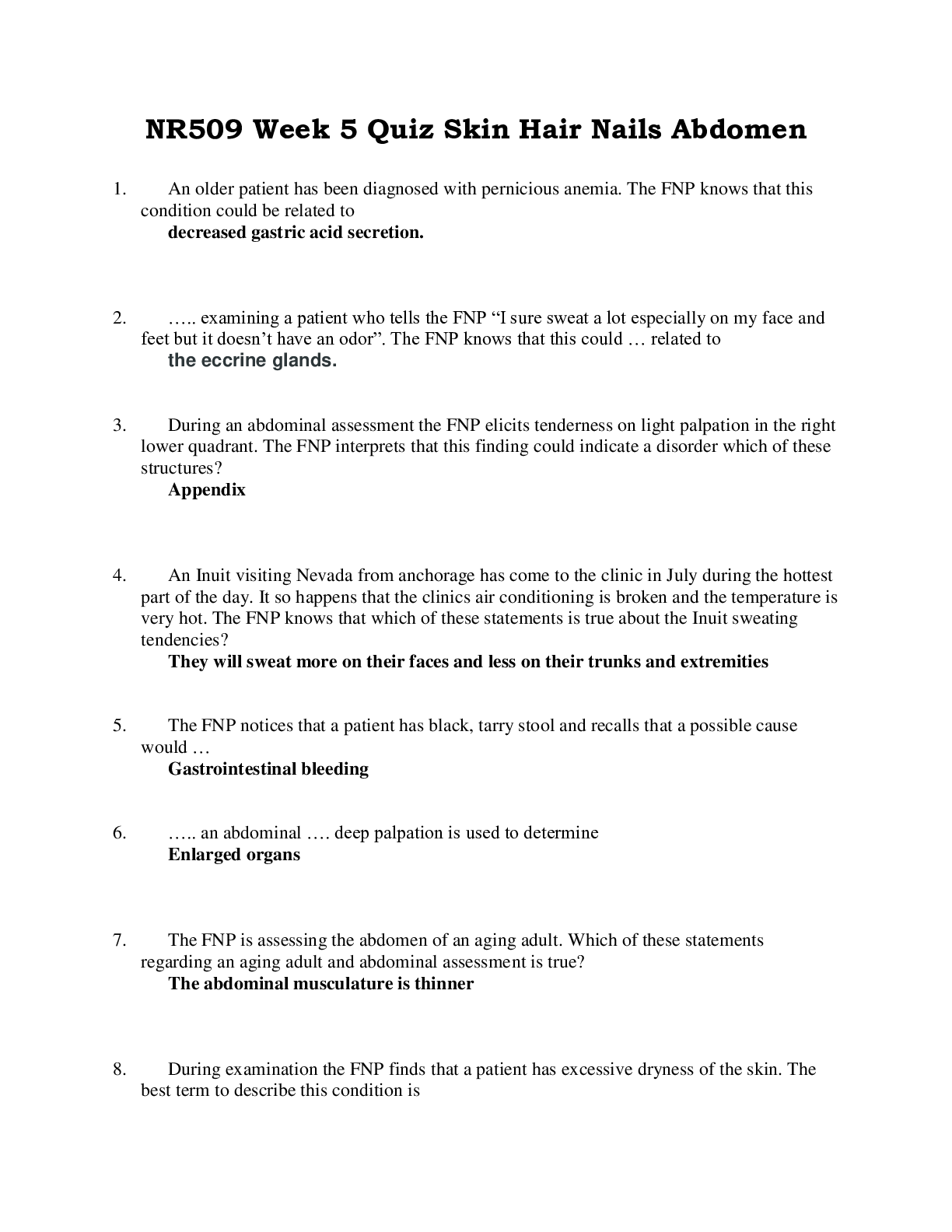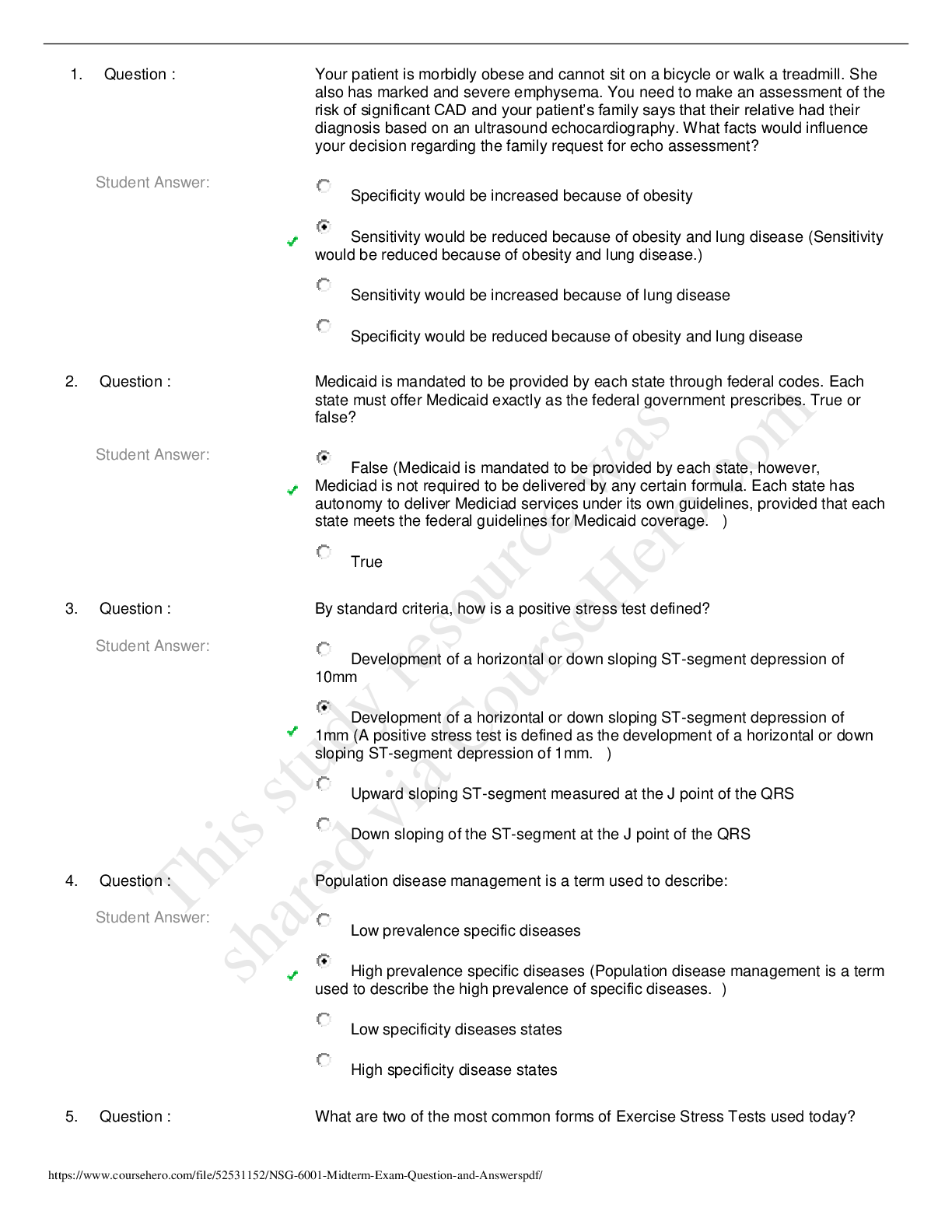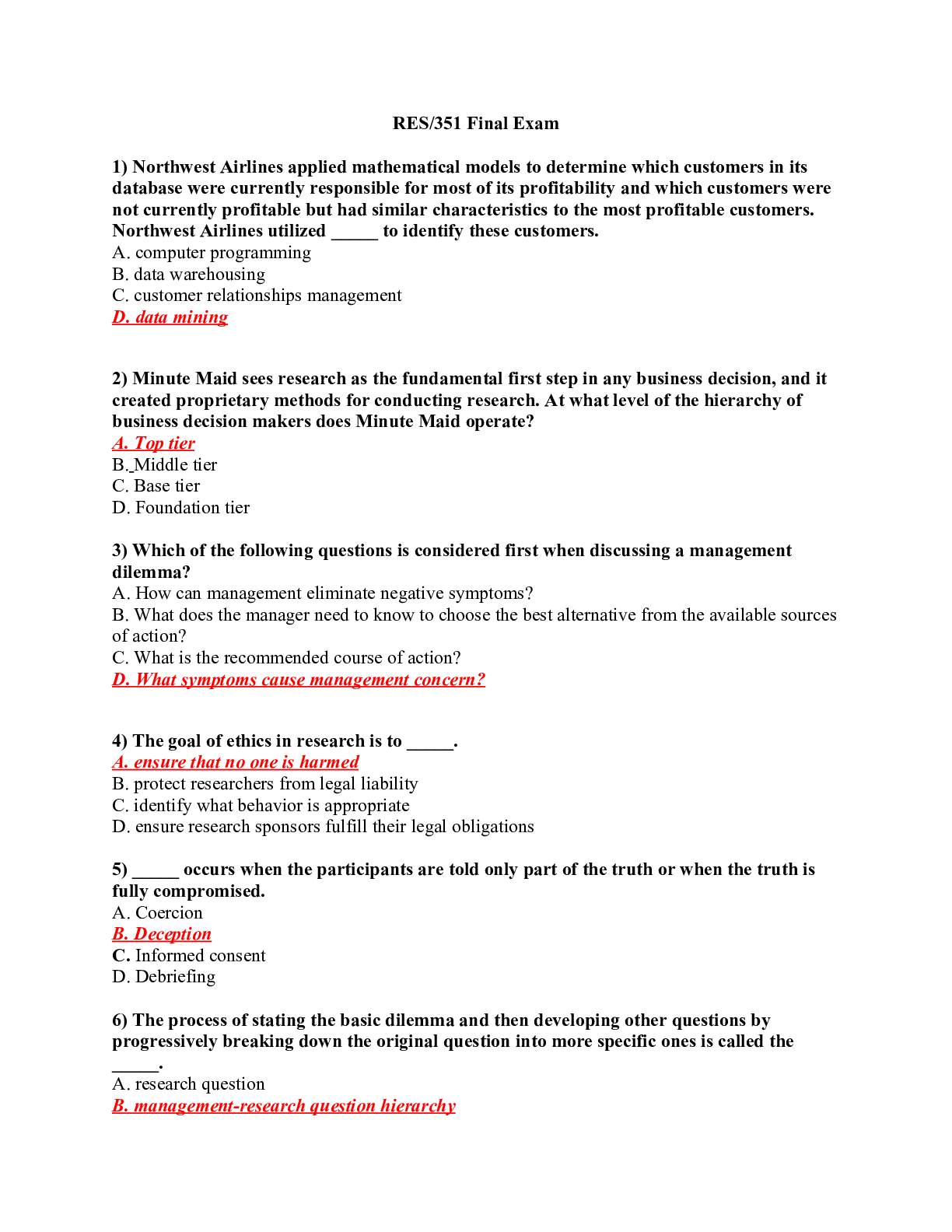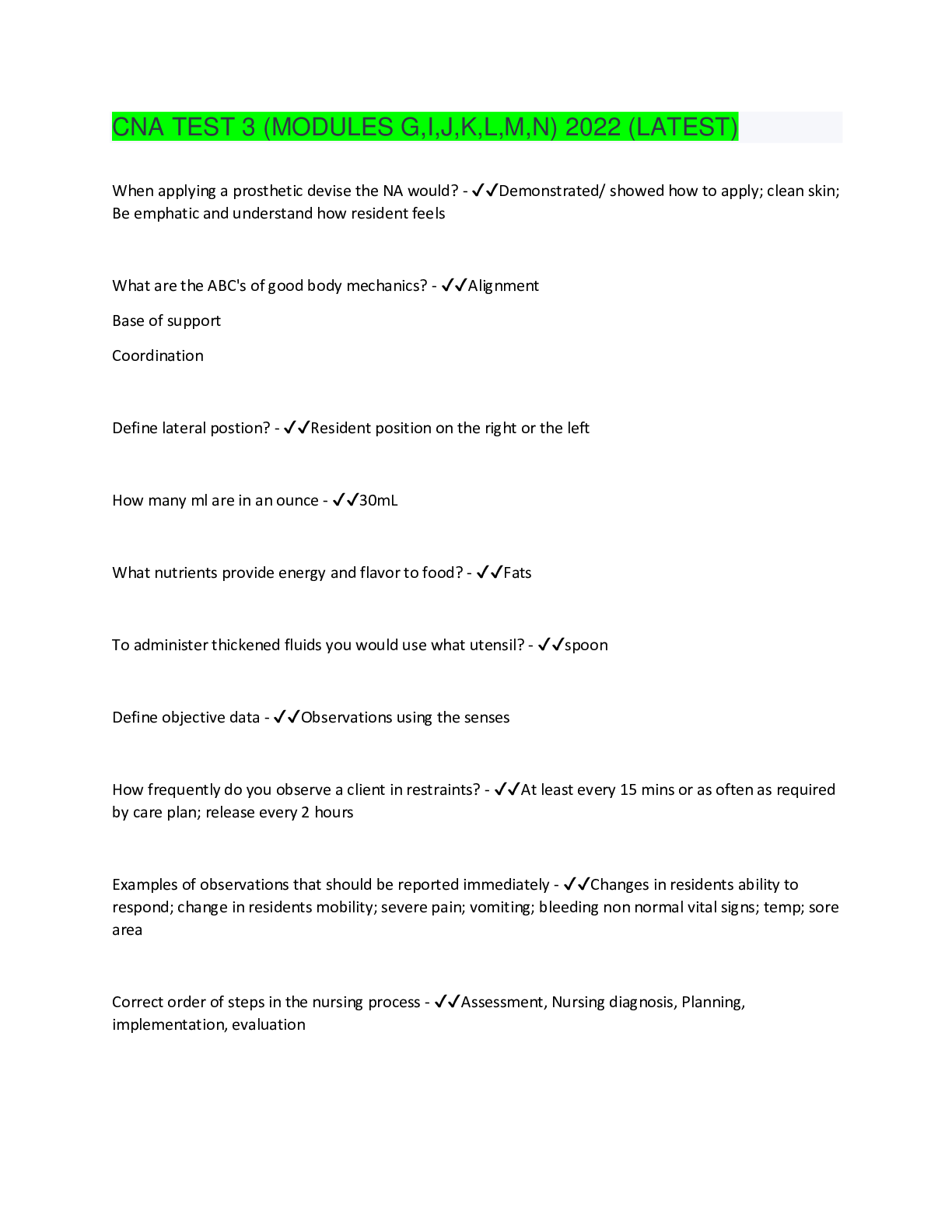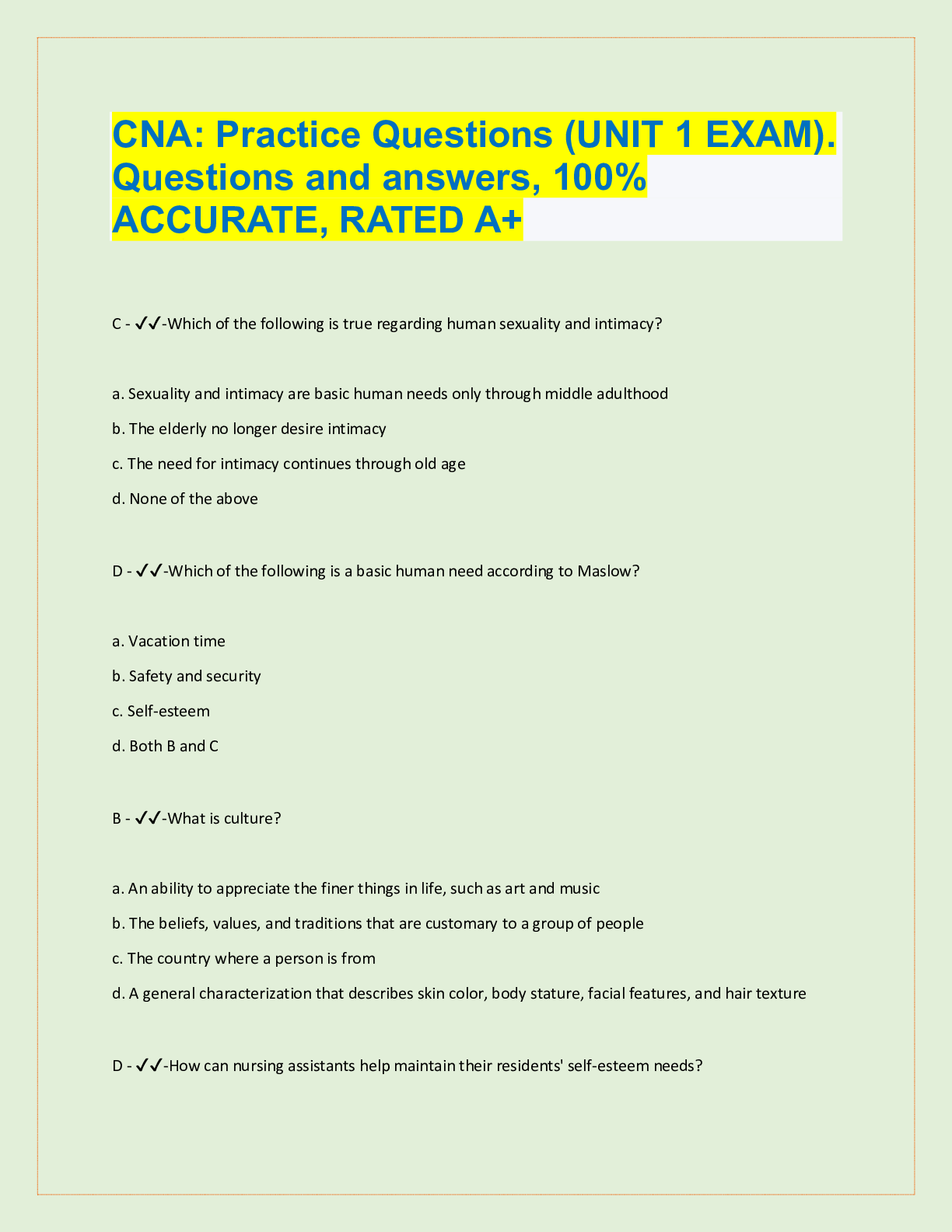Anatomy Final Test for CNA (Certified Nursing Assistant)
Document Content and Description Below
Anatomy Final Test for CNA (Certified Nursing Assistant) Anatomy Final Test for CNA (Certified Nursing Assistant) 1. To maintain certification the CNA must do what? a. Work an 8 hour shift ever... y 12 months b. Never have a verified complaint against them on the register c. Be offered at least 12 hours of in service every 24 months d. None of the above 2. Never document a procedure performed on a resident till it is complete. True or False 3. 1400 in military time is considered what? a. 1pm b. 4pm c. 2pm d. 10am 4. Which of the following is considered true of an advanced directive? a. An advanced directive can be spoken or written b. An advanced directive can be used when the resident or patient is mentally incompetent c. An advanced directive can prevent certain people from making healthcare decisions on the patients behalf d. A and b only e. A b and c 5. True or False- Cheyne-Stokes is a sign that a resident is near death pg 142 6. Care of the dying resident includes what a. Offer the residents their favorite foods b. Call the family and let them know that the residents health is declining c. Obtain a copy of the residents advanced directive d. None of the above 7. Signs and symptoms’ of impending death include which of the following a. Rapid pulse b. Resident stares but does not respond c. Low blood pressure d. A and b only e. None of the above 8. Write Out: DNR stands for what? i. Do not resuscitate 9. Write out: name three ways to welcome a resident to his or her environment, have room ready, introduce to family, introduce to call light 10. Non-insulin dependent diabetes mellitus is called what? a. Type 1 b. Type 2 11. usually occurs in children a. type 1 b. type 2 12. True or false- Signs and symptoms of hyperglycemia include cold clammy skin, blurred vision and increased confusion 13. T OR F- inability to tolerate cold is a sign of hypothyroidism ? 14. Emesis means to vomit -True 15. Define incontinence- Inability to control B/B 16. Weakening of muscles is called what? B: Atrophy 17. Symptoms of schizophrenia include what = A: loss of interest in everyday things 18. Insuring that doors are locked and secured= B: Elopement 19. Loss of ability to respond to respond to the environment is a symptom of what stage of Alzheimer’s disease = D? stage 7 20. Seeing persons or things that are not there= B: hallucinations 21. Believing things that are untrue- A: delusion 22. CNA interventions to a resident who is sun downing include what ? a. Reduce caffeine from evening fluids b. Remove triggers c. Redirect d. A and b only e. A b and c 23. Name three signs and symptoms of pain= clenching teeth, nausea, vomiting, frowning 24. Before placing dentures in a resident mouth the can should do what? a. Apply gloves b. Rinse dentures with mouthwash c. Store dentures in denture cup d. Floss the residents teeth 25. When the CNA completes colostomy care for resident you will record any output as what? a. Urinary output b. Bowel movement c. An emesis d. homostasis 26. When communicating with a resident with a vision impairment the CNA should do what? a. Yell loudly in the residents ear b. Place a bright light behind your back so the resident can see you c. = discuss what you see, changes, and what people are doing d. always use sign language 27. What kind of problem exists for a resident who needs elastic stockings a. Urinary b. Respiratory c. Circulatory d. Digestive 28. Standard equipment in the resident rooms = a. Television electric bed and telephone b. Wheelchair, stretcher and mechanical lift c. Table and counter d. Bedside stand, a bed, chair, and over bed table 29. Your residents care plan states to check BP QID, this means to check the blood pressure how often = 4 TIMES A DAY a. QD b. QID c. QOD d. 6 times a day 30. When taking pulse you are using a what? a. Artery b. Vein c. Capillary d. Alveoli’s 31. Restraints require a doctors order and must be released how often? every = 2 hours a. Q1/2 an hour b. QH c. Q2H d. Q4H 32. An occupied bed is made with the what? a. With the resident in a chair b. Assistance of a nurse c. Resident in the bed d. Resident out of the room 33. The term Edema means what? a. Abnormal swelling of the tissue b. Loss of fluid from the tissue c. Instilling fluid in the rectum d. The same as dehydration 34. The CNA should record INO as what? a. corpseS? b. Cups and gathers c. Cubic Centimeters/ millimeters d. Centigrade or Fahrenheit 35. The extent to which a person is capable of moving a joint is called what? a. Flexibility b. Body mechanics c. Restoration d. Range of motion 36. A resident has died and you are doing post mortem care. The rights to privacy is what ? a. No longer necessary b. Still protected after death c. Only for the family d. Only for the funeral home 37. Helping the resident reach their highest level of ability is the goal of what? a. Range of motion b. Disease prevention c. Rehabilitation d. Supination 38. Guidelines to documentation are what? a. Write all entries in pencil b. Document all observations and performances at the end of the shift c. You may document for someone else d. all of the above e. none of the above 39. Arthritis is an inflammatory condition of the joints and the symptoms are what? a. Redness, swelling, heat, and hunger b. Headache nausea heat and pain c. Redness swelling heat and stiff muscles d. Redness, swelling, heat and pain e. None of the above 40. The residents call light should always be placed where? a. On the bed b. Within residents reach c. On the clients side d. Over the side rail 41. If a resident starts to fall never try to stop the fall a. True 42. A material safety data sheet is a tool in the prevention of what? a. Chocking b. Seizures c. Falling d. Poisoning 43. Define RACE – write out a. R- remove residents from area of immediate danger A- Activate the firm alarm C- Contain the fire, if possible E- Extinguish, if possine 44. Define PASS- Write out a. P- Pull the pin b. A- Aim at the base of the fire c. S- Squeeze d. S- Sweep back and forth at the base of the fire 45. The CNA should always wash the residents body from to a. Dirtiest to cleanest b. cleanest to dirtiest 46. Name 5 observations that should be reported to nurse during oral care- Write out - odor, chipped teeth, redness, bleeding, discoloration 47. Name three circumstances when an electric razor should not be used- pacemaker, near water, oxygen 48. Paralysis on one side of the body is called what – a. Hemiparesis b. Hemiplegia c. Quadraplegia d. paraplegia 49. What is normal input and output for adult – a. 2,500 -3,000ccs b. 2,000-2,500 ccs c. 1,500-2,000 ccs 50. Proper nutrition- a. Helps to maintain muscle b. Aids in the healing process c. Helps prevent pressure sores d. A and c only e. A b and c only 51. Proper hydration a. aids in elimination!!! b. provides fibers for bile elimination c. effects balance d. none of the above 52. How often should cna repostition needed care- 2 hours a. Q4h b. QH c. Q2H d. Q8H 53. Most essential nutrient for life-write out a. Water 54. Name three bony areas-write out a. Shoulders ears elbows hip bone ankles coccyx 55. Name three friction areas-write out a. Under breasts, under arm, between thighs, under abdomen 56. Which joint do you start with doing ROM- write out a. Shoulders 57. What do you check joints for before doing range of motion a. Warmth odor moisture pain b. Redness swelling cooling pain c. redness, swelling, warmth and pain d. redness swelling odor pain 58. What do you check fingers and hands for before doing nail care- a. color, splits., swelling cuts extreme heat or cold b. color moisture dirt swelling c. color splits swelling cuts and redness 59. When you are passing a meal tray, what do you look for on the meal card? a. Name correct food likes dislikes correct utensils and condiments b. Name, diet, correct foods, likes dislikes, correct utensils and condiments c. Name diet and correct utenstils only 60. What is normal pulse range – a. 80-100 per minte b. 70-100 per minute c. 60-100 per minute 61. What do you look for when taking pulse- a. Rate, rhythm b. rate rhythm force c. rate rhythm and beat 62. What is the normal range for respiration? a. 10-24 breaths per minute b. 20-40 breaths per minute c. 12-20 breaths per minute 63. What is respiration? a. How hot the body stays b. The heartbeat c. Rise and fall of the chest?? 64. How long do you take the pulse for respiration? a. 30 seconds b. 45 seconds c. 60 seconds 65. Where do you take the temperature for axillary? a. Mouth b. Rectum c. armpit 66. What is systolic number of the BP- a. Second beat heard b. The first beat heard 67. What is the diastolic number of the blood pressure? a. Last beat heard b. 5th beat heard c. first beat heard 68. A draw sheet is used to blank a resident where? a. Slide b. Turn c. Lift d. Move up in bed e. Ab and d only f. bc and d only 69. Where is the positioning of the catheter tubing when a resident is lying in bed a. Under the leg b. Over the leg c. Over the side rail 70. Which is subjective observation a. Resident tells you I have a headache b. Resident is incoherent c. Residents legs are swollen d. Resident has a skin tear on his left arm 71. Which is an objective information? a. Resident says I’m nauseated b. Resident says I’m hungry c. Resident has a skin tear on the right leg d. Resident goes out with the family 72. Normal range for oral temp- a. 98.6-100.6 b. 97.6- 99.6 c. 96.6-98.6 73. Define Hospice- Care for individuals who have an estimated 6 months or less to live 74. When giving a shower what do you do first? a. Wash the residents face, neck, and ears b. Wet a resident after you have checked the water c. Have the resident check the water d. Wash legs chest and arms 75. Side rails consider to be = all of them 76. How many pillows do you need when placing a resident in a lateral position =4 a. 2 b. 4 c. 5 d. 3 77. Which side would you dress first if the resident has left side weakness- a. Left side b. Right side 78. What artery do you use when taking the pulse- radial a. Brachial b. Carotid c. Radial d. Apical 79. What abnormal findings would you report to the nurse when doing catheter care- a. Feces color and amount b. Placement of catheter and draning of yellow urine c. Leakage irritation and secretion 80. Which artery do use when taking Blood Pressure- Brachial 81. Which resident would you use a fractured bed pan for ? a. A resident weighing 200 lbs b. Resident weighing 195 lbs c. Resident with a broken ankle d. Resident with a broken hip 82. How do you remove your gloves –not a write out- grasp outer surface of other glove, just below cuff by pulling down. Pull glove off so that it is inside out. Hold the removed glove in a ball of the palm of your gloved hand, do not dangle glove downward. Place two fingers of ungloved hand under cuff of other glove and pull down so first glove is inside second glove, dispose without touching outside glove and wash hands 83. Role of CNA- a b c and d a. Provide daily care like bathing, dressing, etc. b. Provide residents with comfort c. Provide for residents safety d. Respond to any call lights e. A and e only f. Abc and d 84. Standard human precautions apply to what- a. All human blood b. All body fluids secretions and excretions except sweat regardless if they contain visual blood or not c. Non-intact skin d. All of the above 85. The universal sign that indicates choking a. Hitting your back b. Both hands on your neck c. Hands on your knees d. Holding your stomach 86. Where is your center of gravity- a. Pelvic b. Ankle c. Shoulders d. Knees 87. An open bed is made when the resident is getting out of the bed for a short time- true 88. When making a closed bed spread is pulled under pillow- false 89. Occupied bed is made when – a. When a resident cannot get out of bed b. When a resident gets out of the bed for the day c. Resident is getting out of the bed for a short time d. Both a and c 90. What is a urinal- container used by male a. a device placed under a bed ridden resident to collect urine or feces b. a small kidney shaped pan used for spit or vomit c. a container used by the male residents to void d. none of the above 91. What is a bed pan- urines or feces a. Device placed under a bed ridden resident to collect urine or feces b. A small kidney shaped pan used for spit or vomit c. A container used by a male resident to void d. None of the above 92. What is an emesis basin – a. Device placed under a bed ridden resident to collect urine or feces b. A small kidney shaped pan used for spit or vomit c. A container used by a male resident to void d. None of the above 93. True or false? An unoccupied bed can be either closed or open- true 94. Write out- Why is it important to make one side of the bed at a time- less stressful, more efficient and quicker 95. To identify before beginning a procedure the can should do what - a and d only a. Check the information bracelet b. Ask the roommate c. Ask family members d. Call resident by name and observe for response e. A and d only f. All of the above 96. Resident has a contracture of his right leg, this is what? a. Permanent loss of muscle tissue b. Lesion c. Spasm d. Tightening of a muscle 97. Which directions do you wash your hands- wrist to finger tips a. Elbow to finger tips b. Fingers to wrist c. Wrist to finger tips 98. What are side rails considered to be? a. Safety device and restraint only b. Safety device, brace, and restraint c. Safety device, self help device, and a restraint 99. Define privacy and write out - free of being observed or disturbed by other people 100. True or false? The call light must be placed on unaffected side- true 101. Mr. Flunders is confused and wondering. The CNA must monitor him how often ?– a. As much as possible b. If he is more confused than usual c. When he gets near a door d. At all times 102. Which resident would require more frequent oral care- a. Breathing with his mouth closed b. Having normal temperature c. Drink plenty of water d. Unconscious 103. When dressing a dependent resident, which part of the body do you dress first? a. Arm neck abdomen b. Upper parts of the body c. Lower parts of the body 104. The nurse tells you to help Mr. McGee into his wheel chair. To prevent an accident you should first do what- lock breaks a. Lock the breaks on the wheel chair before transferring him b. Tell Mr. Mcgee to help you or you may drop him c. Place the wheel chair behind you so that it is not in your way d. Ask two other nurses assist to help you lift him into the chiar 105. Parkinson’s disease affects what? – a. Physical functions only b. Intelligence only c. Both physical functions and intelligence d. Neither physical functions nor intelligence 106. Which commonly used position promotes breathing and puts less pressure on the coccyx a. Supine b. Lateral c. Fowlers d. Semi-fowlers 107. Which common position can be used during oral care and grooming- fowlers a. Supine b. Lateral c. Fowlers d. Semi-fowlers 108. Which commonly used position can be used for bed making, bed bath, and perineal care- supine a. Supine b. Lateral c. Fowlers d. Semi-fowlers 109. How long should the CNA have a resident dangle feet before they get up from a sitting position – a. 10-15 seconds b. 5-10 seconds c. 15-20 seconds d. 60 seconds 110. True or false- A cna can initiate cpr if qualified – true 111. Define delegate- to give permission to another person to perform a task on your behalf 112. Name 5 moments hand hygiene – i. before touching a patient ii. before clean/aseptic procedures iii. after body fluid exposure iv. after touching a patient v. after touching a patient surroundings 113. pulse located on neck write out- carotid 114. pulse is located on the left side of the chest and breastbone write out- apical 115. pulse is located inside the wrist- radial 116. pulse is used for taking blood pressure write out- brachial 117. Match these words: expiration- exhaling air out of the lungs 118. Inspiration- breathing air into the lungs 119. Hypoglycemia- low blood sugar 120. Hyperglycemia – high blood sugar 121. 6 links of infection – i. infectious disease-microorganism ii. portal of exit iii. mode of transmission iv. portal of entry v. susceptible host on [Show More]
Last updated: 1 year ago
Preview 1 out of 14 pages
.png)
Buy this document to get the full access instantly
Instant Download Access after purchase
Add to cartInstant download
We Accept:

Reviews( 0 )
$10.00
Document information
Connected school, study & course
About the document
Uploaded On
Nov 08, 2022
Number of pages
14
Written in
Additional information
This document has been written for:
Uploaded
Nov 08, 2022
Downloads
0
Views
177

